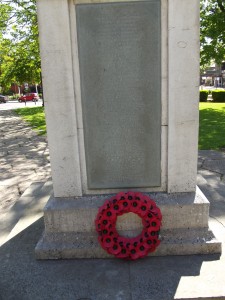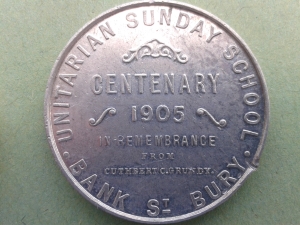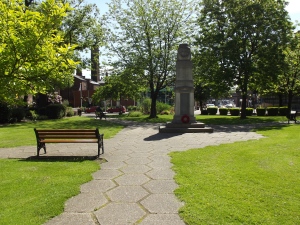The Great War Project begun by Faith and Freedom is attracting a lot of positive interest and more material is being added, almost on a daily basis. Within the memorial section there soon will be added some pictures of the Cenotaph at Bury Unitarian Church which have been sent in by Neville Kenyon, many of which are reproduced here.

Neville suggests that this is the only Unitarian Cenotaph and I suspect that he must be right. Of course, Cenotaph means, literally, ‘empty tomb’ and in amongst the many old and quite extensive graveyards that exist around the country there must be a few tombs that fall into that category for one reason or another. But by Cenotaph we generally mean a freestanding public monument inspired by the Cenotaph in Whitehall, and repeated in many cities, towns and villages.

The idea for Cenotaphs came from the experience of the First World War when so many soldiers had no known grave. In such a situation there was a need for a focus of remembrance, something that could symbolise the sacrifice and loss that was felt by so many people. To this end the Whitehall Cenotaph and all those that came after it fulfilled a very special role in national consciousness. And how different such monuments are when we compare them with other memorials that were erected following wars such as the Arc de Triomphe or the Brandenburg Gate, to name just two. Unlike them there is no overt military symbolism in the Cenotaph. It is much more restrained, much more dignified.
In 1924 the author H.V. Morton described his feelings as he stood near the Cenotaph on an ordinary morning:
I look up at the Cenotaph. A parcels delivery boy riding a tricycle van takes off his worn cap. An omnibus goes by. The men lift their hats. Men passing with papers and documents under their arms, attache and despatch cases in their hands – all the business of life – bare their heads as they hurry by.
Six years have made no difference here. The Cenotaph – that mass of national emotion frozen in stone – is holy to this generation. Although I have seen it so many times on that day once a year when it comes alive to an accompaniment of pomp as simple and as beautiful as church ritual, I think that I like it best just standing here in a grey morning, with its feet in flowers and ordinary folk going by, remembering.
The Bury Cenotaph is very public and very similar to the memorials that are more often municipal, regimental or governmental in origin. It commemorates the members of three congregations who served in the First World War, with the names of those who served in the Second World War being added later. These were three long-established local congregations, who amalgamated into one with a bold new meeting house in 1974.

The Cenotaph is situated in front of the church in the centre of what was the graveyard but which is now a public space. This space was originally called Library Gardens but has recently been renamed by the council with what seems a much more satisfying designation of Church Gardens. Neville tells me that on Remembrance Sunday the congregation meets at 11.00 am at the Cenotaph for the one minute silence, the Last Post is played, before the congregation goes into the church for a service of remembrance, the names of those inscribed on the memorial being read.
There is a plaque to commemorate each of the three congregations represented by the modern congregation – Chesham, Heywood and Bank Street, Bury. The Bank Street plaque – beneath the title ‘Bank Street Presbyterian Chapel Unitarian’ – has the longest list of names (I counted 40 names from the First World War) but it is by far the most weathered.

There are 23 names from the First World War on the Heywood memorial and five on the Chesham memorial.


In my possession I have a medal struck to commemorate the centenary of the Bank Street Sunday School in 1905. The medal is inscribed ‘In Remembrance from Cuthbert C. Grundy’ and it must have been given to all the Sunday School scholars at the time. It is sad to think that so many of the children who received this medal in 1905 will be amongst the long list of volunteers whose names were inscribed on the Cenotaph just a few years later.

Is it the only Unitarian Cenotaph? If you know of any other please let me know and, best of all, send a picture. The only place that I know that comes near is Ullet Road Church in Liverpool which has a memorial set in its own large and well-kept grounds. But although it is a First World War Memorial that performs the same role as a Cenotaph the design is different to that of Bury, although not dissimilar to ones found in many places around the UK.

But it would be nice to hear if anywhere else possesses a memorial in any way similar to that of Bury. Or maybe Bury is unique?

Fascinating article – thank you. Any idea what happened to all the recumbent gravestones that used to cover the area of the graveyard?
LikeLiked by 1 person
Thanks. I have to confess that I don’t know what happened to the gravestones that used to be in the graveyard. It may be that some of the people from Bury who read this blog could tell us, it would be interesting to know.
LikeLiked by 1 person
Thanks very much, David.
LikeLiked by 1 person